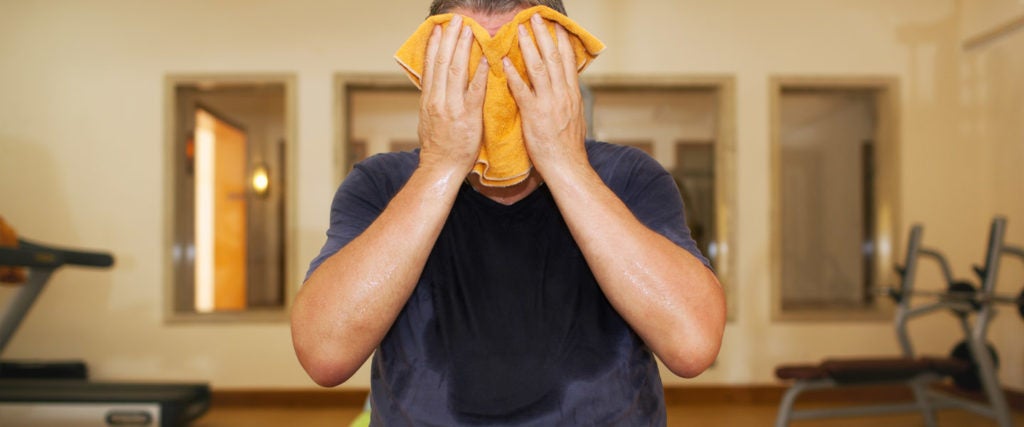We’ve all heard it, some of us have said it, and after a long workout, I’ve admittedly uttered that ultimate weird flex: I work out more for my mental health.
It’s not that it’s dishonest as such — exercising regularly is a huge part of my routine that helps me sleep, focus and gives me an outlet for my anxiety-fueled temper. But while I know that working out benefits me psychologically somehow, beyond that, I have no idea what kind of exercise or how much of it is best for achieving it. The truth is, most of the time I work out “for my mental health” it’s because I don’t know what else to do — it’s my default way of coping during a stressful time, which means it’s easy to overdo it and undercut these mental-health motivations. And since most of us are just guessing what’s best for our mental health anyways, it’s not surprising that we all seem full of shit when we say we’re just working out for that purpose.
Surprisingly, it only really takes about 20 minutes of moderate intensity cardio (e.g., jogging, cycling, swimming or dancing) three to five days a week to achieve maximum mental-health benefits. “That level of effort for longer than 20 minutes increases the receptors in the brain for serotonin and other feel-good hormones. It makes us more sensitive to the good stuff,” explains Darlene Marshall, a personal trainer and health coach with a master’s degree in psychology, citing an endocannabinoid study that demonstrates how the intensity of exercise impacts these brain chemicals.
However, the 20-minute mark refers to “minimal effective dose,” Marshall notes, meaning you can exceed this time frame — but by how much?
“I wouldn’t work out past 45 minutes to one hour,” psychologist and personal trainer Cali Estes tells me. If possible, for best results Estes recommends breaking workouts into two to four shorter workouts throughout the day: “This way you’re flooding your brain consistently with the happy chemicals.”
The moderation detail is key when starting out, because high-intensity workouts don’t show the same mood-boosting effects. “While you might tell yourself that high-intensity workouts boost your mood, that could be a placebo,” says Marshall. It’s also easy to assume that the more stressed, anxious and depressed you are, the more intense the exercise you’re going to need, but a review of the scientific literature on the subject debunks that notion. “The relationship between exercise duration and mood change is non-linear. A regime of 10- to 30-minute exercise is sufficient for mood improvements,” researchers have written, further confirming that “moderate-intensity anaerobic exercise is associated with greater mood improvements.”
That said, this doesn’t necessarily mean that high-intensity exercise is bad for your mental health. “There’s a sense of real accomplishment that comes when you’re working through something hard. That aspect is understudied, to my knowledge,” Marshall admits. Likewise, another study found that participants didn’t enjoy high-intensity exercise at first, but after about six weeks of doing it, they liked it. Comparatively, participants enjoyed moderate exercise right away but preferred lower intensity overall. And while enjoying the workout doesn’t determine mental-health benefits entirely, it certainly helps.
“The trick seems to be picking something you like doing and to work at a level where you’re huffing and puffing, but could sustain it indefinitely,” Marshall says. In this case, dancing in your living room can be as effective as running as long as you enjoy doing it. Perhaps that’s why guys who participate in team sports are less vulnerable to depression and anxiety — not just because they’re getting regular exercise, but because they’re enjoying themselves.
No matter what you decide to do, engaging in a variety of activities (instead of the same workout over and over again) is just as important to making mental gains as physical ones. “When it comes to movement for mood, happiness and well-being, variety is partly for interest,” Marshall says. When running or cycling become boring, you can do yoga, hiking or a dance class, she suggests. “With so little variety in our lives under COVID,” she says, “this is one place you can add variety, excitement and learning something new.”
There’s even a place for higher-intensity and lower-intensity workouts in this variety. Marshall recommends starting with moderate exercise for the immediate mood boost, but mixing it up from there, “adding in short bursts of higher intensity to challenge them,” she says. “As they start to enjoy those challenges, then I incorporate the full-on HIIT workouts.”
It’s also been good for my mental health to be honest about my motives for working out, and sometimes those are shallow as hell. As much as I workout for my psyche, I also do it for the more fleeting dopamine hit from likes on a post-workout thirst trap. These aren’t mutually exclusive goals and there’s plenty of overlap, but if I get too intense about either, it will backfire.
I might not get it right every time, but now when I say that I’m only working out for my mental health, at least I know what it means — I have an excuse to call it quits after 20 minutes.

